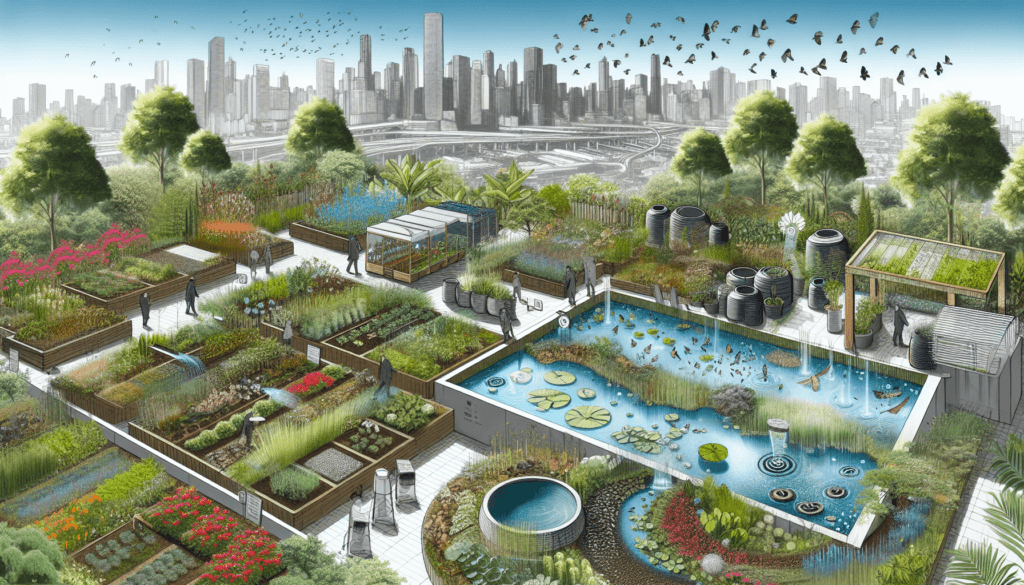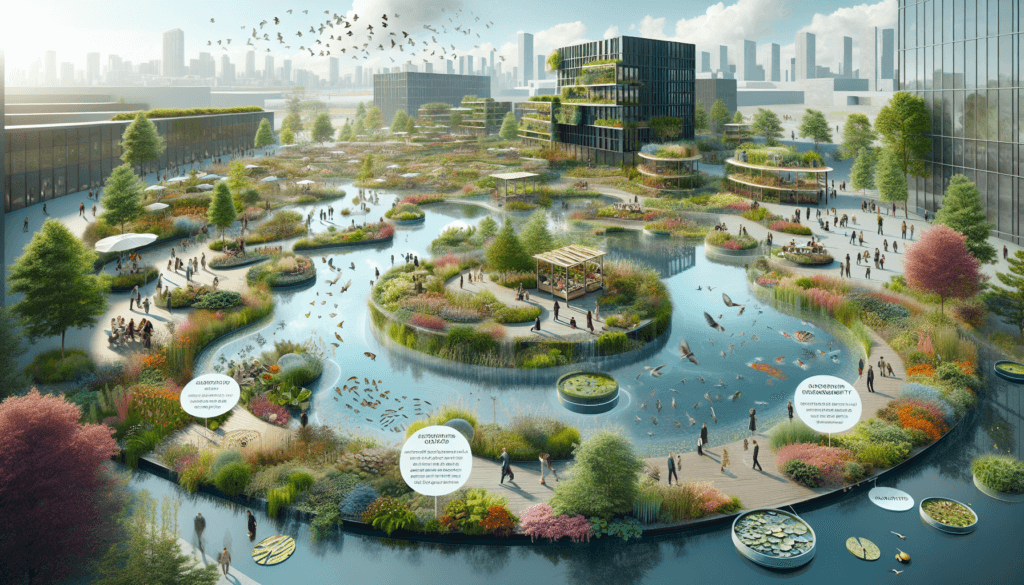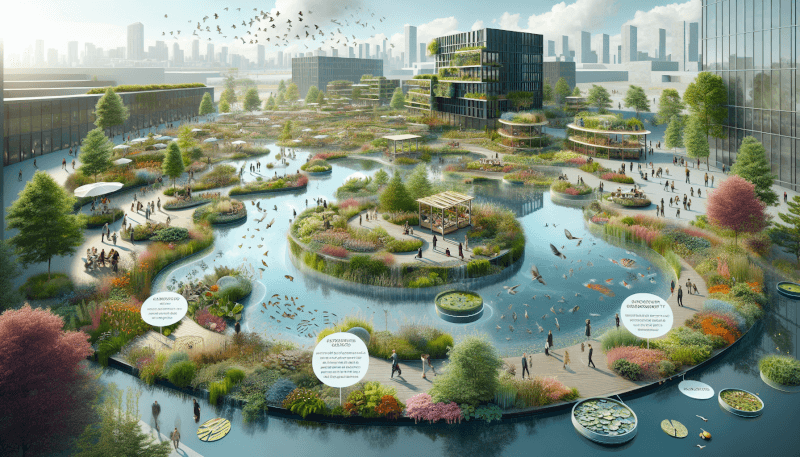In the world of urban gardening, the concept of replicating nature has taken center stage, as more and more people seek to transform their concrete jungles into thriving green spaces. The trend of creating ecosystems within urban gardens is not only aesthetically pleasing, but it also has numerous benefits for both humans and the environment. By carefully incorporating various elements such as native plants, water features, and inviting habitats for wildlife, urban garden designers are able to mimic the intricate balance found in natural ecosystems. This article explores the fascinating world of replicating nature in urban garden design and highlights the importance of creating ecosystems in our urban environments.

Planning for Urban Gardens
Assessing available space
Before you begin planning your urban garden, it’s essential to assess the available space you have. Take a look at your balcony, rooftop, or any other area you intend to transform into a garden. Consider the size and shape of the space, as well as any limitations or restrictions that may exist. Understanding the dimensions and characteristics of your available space will help you determine what types of plants and design elements will work best.
Considering environmental factors
When planning your urban garden, it’s important to take into account the environmental factors that may impact its success. Things like sunlight, wind patterns, and temperature variations can greatly affect the growth and health of your plants. Observe how the sun moves across your space throughout the day and identify any areas that receive more or less sunlight. Additionally, consider the potential for strong winds and fluctuations in temperature, as these factors will influence the types of plants that can thrive.
Determining the purpose of the garden
Before diving into the design process, it’s crucial to determine the purpose of your urban garden. Are you aiming to grow your own food, create a serene retreat, or attract wildlife? Defining your garden’s purpose will help guide your choices when it comes to plant selection, layout, and design elements. Whether you envision a vibrant vegetable garden or a peaceful oasis, clarifying your goals will ensure that your urban garden serves its intended purpose effectively.
Design Principles for Urban Gardens
Emphasizing biodiversity
One of the key design principles for urban gardens is to emphasize biodiversity. By incorporating a variety of plant species, you can create a more resilient and ecologically balanced ecosystem. Biodiversity not only enhances the aesthetics of your garden but also helps attract beneficial insects, birds, and other wildlife. Consider including a mix of flowers, shrubs, and trees that bloom at different times throughout the year to provide a continuous food source for pollinators.
Creating habitat diversity
In addition to promoting biodiversity, it’s important to create habitat diversity within your urban garden. By providing a range of habitats, such as nesting sites, shelters, and water features, you can attract a greater diversity of wildlife. Incorporate birdhouses, bat boxes, and bee hotels to provide safe havens for these important creatures. You can also add rocks, logs, and native plants to create a diverse and inviting habitat for insects, reptiles, and small mammals.
Utilizing vertical space
When designing an urban garden, it’s crucial to maximize the use of vertical space. In smaller areas, utilizing vertical gardening techniques can significantly increase the amount of available growing space. Consider installing trellises, vertical planters, and hanging baskets to grow climbing plants, herbs, and flowers. This not only adds visual interest but also allows you to make the most of limited space. Additionally, vertical gardening helps to create a more lush and layered garden, replicating the natural habitats found in traditional ecosystems.

Incorporating Native Plants
Benefits of using native plants
Incorporating native plants into your urban garden offers numerous benefits. Native plants are well adapted to the local climate, making them more resilient and requiring less maintenance and water. They also provide vital resources for native wildlife, including food and shelter, while supporting the overall health and biodiversity of the ecosystem. By planting native species, you can also help preserve and restore natural habitats within urban areas.
Choosing appropriate native plants
When selecting native plants for your urban garden, consider the specific environmental conditions of your area. Choose plants that are native to your region and are well-suited to the available sunlight, soil type, and moisture levels. Research the growth habits and requirements of different native species to ensure they will thrive in your garden. Additionally, choose a mix of plants that provide year-round interest, including those that bloom in different seasons and offer a variety of textures and colors.
Creating a balanced ecosystem
Incorporating native plants into your urban garden helps create a balanced ecosystem by attracting a diverse range of wildlife. Native plants provide a source of food, nectar, and shelter for insects, birds, and small mammals. They also support the life cycles of pollinators, important for the reproduction of many plant species. By designing your garden with native plants, you can help restore and maintain the delicate ecological balance that exists in natural habitats.
Attracting Wildlife to Urban Gardens
Providing food sources
To attract wildlife to your urban garden, it’s important to provide a variety of food sources. Incorporate a mix of native plants that produce nectar-rich flowers, berries, and seeds throughout the year. This will attract butterflies, bees, and birds to your garden. Consider planting fruit trees, such as apple or cherry, which provide food for birds and mammals. Additionally, leave spaces for fallen leaves and twigs as they provide nourishment for insects and decomposers.
Creating water features
Water features are a crucial element for attracting wildlife to your urban garden, especially during the hot summer months. Consider incorporating a small pond, birdbath, or even a decorative fountain. These water sources provide vital hydration for birds, butterflies, and other creatures. Adding shallow areas or rocks in your water feature allows insects and amphibians to drink and breed. Just remember to keep the water clean and regularly change it to prevent the growth of mosquitoes.
Providing shelters and nesting sites
To encourage wildlife to take up residence in your urban garden, it’s important to provide suitable shelters and nesting sites. Install birdhouses, bat boxes, and insect hotels to attract a variety of species. Add dense shrubs, trees, and tall grasses to offer protection and cover for small mammals, birds, and insects. Consider strategically placing logs and rocks to create basking spots for reptiles. Designing your garden with a variety of habitats will support a diverse range of wildlife and create an ecologically rich environment.

Managing Water in Urban Gardens
Implementing efficient irrigation systems
When it comes to managing water in urban gardens, implementing efficient irrigation systems is essential. Drip irrigation, soaker hoses, or microsprinklers can help minimize water waste by delivering water directly to the plant’s root system. These systems reduce evaporation and ensure that water is used more effectively. Implementing timers or moisture sensors can further optimize water usage by only watering when necessary. By using efficient irrigation methods, you can conserve water and promote the health of your urban garden.
Harvesting rainwater
Another effective way to manage water in your urban garden is by harvesting rainwater. Set up rain barrels or tanks to collect rainwater from your rooftop or balcony. This collected water can then be used to irrigate your plants during dry periods, reducing the need for tap water. Harvesting rainwater not only conserves this precious resource but also helps reduce the strain on local water sources.
Minimizing runoff and water waste
Minimizing runoff and water waste is an important aspect of managing water in urban gardens. Design your garden with permeable surfaces, such as gravel or porous paving, to allow water to infiltrate the soil instead of running off into storm drains. Avoid overwatering your plants, as excess water can lead to runoff and nutrient leaching. By following sustainable watering practices and employing water-saving techniques, you can minimize water waste and contribute to a more eco-friendly urban garden.
Utilizing Composting and Recycling
Benefits of composting and recycling
Utilizing composting and recycling in your urban garden offers numerous benefits. Composting organic waste allows you to create nutrient-rich soil amendments that improve the health and fertility of your garden. By recycling your kitchen scraps, yard waste, and plant clippings, you can reduce the amount of waste that goes to landfills. This reduces greenhouse gas emissions and helps combat climate change. Incorporating compost and using recycled materials also contributes to the overall sustainability of your garden.
Creating a composting system
To create a composting system in your urban garden, you’ll need a compost bin or pile. Select a composting method that suits your space and needs, such as a small compost tumbler or vermicomposting with worms. Add a mixture of brown materials (such as leaves or shredded paper) and green materials (such as kitchen scraps or grass clippings) to your compost pile. Turn the pile regularly to promote decomposition and maintain a healthy balance of carbon and nitrogen. In time, you’ll have nutrient-rich compost to enrich your soil.
Incorporating recycled materials
Incorporating recycled materials into your urban garden is a creative way to reduce waste and add unique elements to your design. Consider using reclaimed wood for raised beds or creating pathways with recycled bricks or gravel. Upcycle old containers into planters or use recycled plastic bottles for vertical gardening. You can also repurpose items like old tires or pallets to create features such as garden seats or trellises. By giving new life to old materials, you can create a visually appealing and sustainable urban garden.

Managing Pests and Diseases Sustainably
Applying natural pest control methods
When managing pests and diseases in your urban garden, it’s best to use natural and sustainable methods. Avoid the use of chemical pesticides and instead opt for biological controls such as beneficial insects, like ladybugs or lacewings, that prey on garden pests. Utilize companion planting techniques by growing plants that repel pests or attract beneficial insects. Regularly inspect your garden for signs of pests or diseases, and take prompt action to prevent further damage. By employing natural pest control methods, you can maintain a healthy and thriving urban garden without negatively impacting the environment.
Encouraging beneficial insects and animals
Encouraging beneficial insects and animals is another sustainable approach to managing pests in your urban garden. Planting flowering herbs and ornamental plants that attract pollinators will also attract beneficial insects that prey on garden pests. Create habitat features, such as insect hotels or birdhouses, to provide shelter for these helpful creatures. Toads, snakes, and bats are natural predators of many garden pests, so consider incorporating features that attract and support these animals. By promoting a healthy and diverse ecosystem, you can naturally control pests while maintaining the balance of your urban garden.
Using organic and non-toxic solutions
If you are faced with especially troublesome pest or disease issues, look for organic and non-toxic solutions. Products containing neem oil, insecticidal soaps, or horticultural oils can help control garden pests without harming beneficial insects or pollinators. Organic fungicides, such as copper-based solutions, can be used to combat fungal diseases. Always read and follow the instructions on product labels carefully, and choose solutions that are safe for the environment, pets, and humans. By using organic and non-toxic solutions, you can effectively manage pests and diseases while minimizing harm to the ecosystem.
Maintaining Urban Ecosystems
Regular monitoring and assessment
To maintain the health and balance of your urban garden ecosystem, regular monitoring and assessment are essential. Keep a close eye on your plants for any signs of pests, diseases, or nutrient deficiencies. Regularly inspect and clean water features to prevent the buildup of algae or stagnant water. Assess the overall growth and appearance of your garden to identify areas that may need adjustments or improvements. By staying proactive and addressing issues promptly, you can ensure the long-term success of your urban garden.
Proper pruning and maintenance
Proper pruning and maintenance are vital for the health and aesthetics of your urban garden. Prune your plants regularly to remove dead or diseased branches, promote proper growth, and enhance airflow. This reduces the risk of pests and diseases and helps maintain the overall vigor of your garden. Proper maintenance also includes regular weeding, mulching, and feeding your plants with organic fertilizers. By keeping your garden tidy, nourished, and well-maintained, you can create a flourishing urban ecosystem.
Seasonal adjustments and biodiversity enhancement
As the seasons change, it’s important to make seasonal adjustments and enhance biodiversity in your urban garden. Adjust your planting and maintenance routines according to temperature and weather patterns. Introduce seasonal flowers, fruits, or vegetables to provide a continuous food source for pollinators and wildlife throughout the year. Consider creating habitat features specifically designed for seasonal visitors, such as overwintering sites for butterflies or birdhouses for migratory birds. By embracing the diversity of each season and making appropriate adjustments, you can ensure that your urban garden remains vibrant and ecologically balanced year-round.

Engaging the Community
Educating and involving community members
Engaging the community is a wonderful way to promote and enhance urban gardening. Educate community members about the benefits of urban gardens and how they can contribute to a more sustainable environment. Offer workshops or classes on garden design, plant care, composting, or other relevant topics. Provide resources and guidance to help individuals start their own urban gardens. By educating and involving community members, you can create a network of passionate and knowledgeable gardeners who can share ideas and support one another.
Organizing workshops and events
Organizing workshops and events further encourages community involvement and allows for shared learning experiences. Collaborate with local environmental organizations, garden clubs, or schools to host gardening workshops or guided tours. Arrange events such as seed swaps, plant sales, or garden festivals to bring together gardening enthusiasts and foster a sense of community. By creating opportunities for people to connect and learn from one another, you can inspire and empower individuals to embrace urban gardening as part of their everyday lives.
Developing collaborative gardening projects
Collaborative gardening projects are an excellent way to engage the community and create a sense of ownership and pride. Seek opportunities to work with local schools, community centers, or organizations to develop shared garden spaces or community plots. Encourage community members to participate in the planning, planting, and maintenance of these projects. Provide ongoing support and guidance to ensure the success of these collaborative efforts. By working together, you can create vibrant and flourishing urban gardens that bring people together and foster a strong sense of community.
Gardening in Small Spaces
Vertical gardening techniques
Gardening in small spaces often requires creative solutions, and vertical gardening techniques are a great way to maximize limited space. Install trellises, obelisks, or arches to support climbing plants, such as cucumbers or ivy. Utilize wall-mounted planters or hanging baskets to grow herbs or trailing flowers. You can also create living walls or green screens using planted panels or mesh. Vertical gardening not only adds visual interest and dimension to your small space but also allows for a more efficient use of vertical real estate.
Container gardening ideas
Container gardening is another versatile option for gardening in small spaces. Choose containers of various sizes and shapes to accommodate different types of plants. Window boxes, hanging baskets, and patio planters can be used to grow herbs, flowers, or even shallow-rooted vegetables. Select plants that are well-suited to container gardening and consider mixing different textures and colors for visual appeal. By using containers, you can create mini-gardens within your small space and easily move them around to optimize sunlight and aesthetics.
Creative use of limited space
When you’re gardening in a small space, it’s important to think creatively and make the most of every inch. Consider utilizing vertical surfaces, such as walls or fences, for hanging planters, trellises, or shelving. Create multi-level raised beds or tiered planters to maximize planting area. Embrace the concept of “gardening in layers” by selecting plants of different heights and growth habits. This adds depth and visual interest to your small space. With a little imagination and resourcefulness, you can transform even the tiniest of areas into a thriving and beautiful urban garden.
In conclusion, planning and designing an urban garden involves careful consideration of available space, environmental factors, and the desired purpose of the garden. By emphasizing biodiversity, creating habitat diversity, and utilizing vertical space, you can create a vibrant and ecologically balanced garden. Incorporating native plants helps support the local ecosystem, attract wildlife, and promote a healthy environment. Attracting wildlife to urban gardens is possible by providing food sources, water features, and shelters. Managing water efficiently through irrigation systems, rainwater harvesting, and minimizing runoff is crucial for sustainable gardening. Utilizing composting and recycling techniques contributes to soil fertility and waste reduction. Managing pests and diseases sustainably involves natural control methods and promoting beneficial insects and animals. Maintaining urban ecosystems requires regular monitoring, proper pruning, and seasonal adjustments. Engaging the community through education, workshops, and collaborative projects fosters a sense of community and shared learning. Gardening in small spaces can be achieved through vertical gardening, container gardening, and creative use of limited space. By following these principles and techniques, you can successfully create and maintain a thriving urban garden that not only beautifies your surroundings but also contributes to a more sustainable and ecologically friendly environment.


